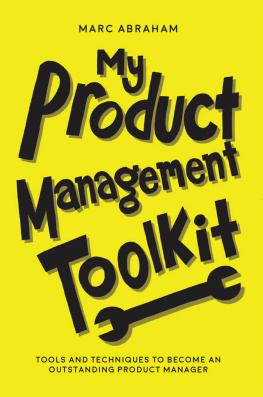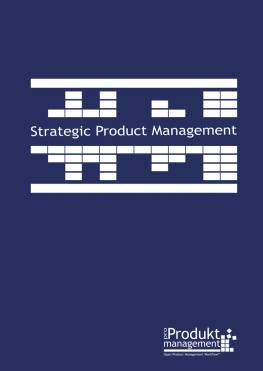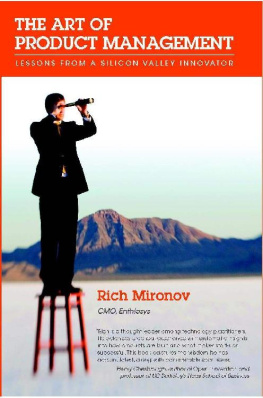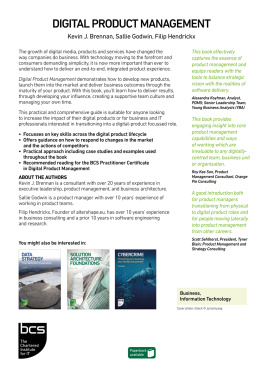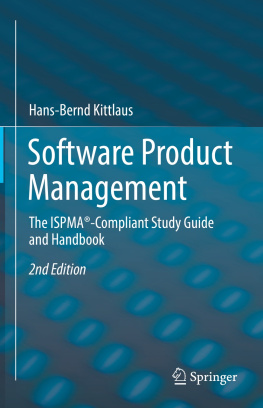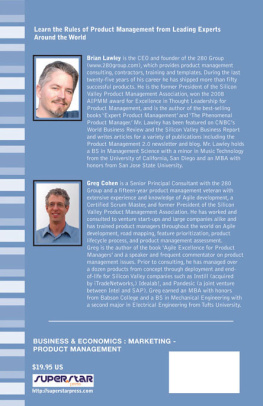
MY PRODUCT MANAGEMENT TOOLKIT

MY PRODUCT MANAGEMENT TOOLKIT
Tools and Techniques to Become an Outstanding Product Manager
MARC ABRAHAM
2018 Marc Abraham
All rights reserved.
ISBN-13: 9781984007315
ISBN-10: 1984007319
Library of Congress Control Number: 2018901700
CreateSpace Independent Publishing Platform
North Charleston, South Carolina
To my amazing family, Tracy, Oscar, and Zac
CONTENTS

INTRODUCTION
WHY THIS BOOK?
O ver the past few years, many people have asked me for practical advice about product management. Take Stephen, for example, founder of an early-stage start-up who wanted to know how to conduct customer research on a shoestring budget. Or Rita, who had been a product manager for only a short while and asked me about how to best create and drive a product vision.
People like Stephen and Rita inspired me to write down my own lessons learned and the tools I used as a product manager. I published my first blog post, titled My Product Management Toolkit, in January 2016, and I wrote about how to best create a product vision.
The number of views, the quality of the feedback I received, and the range of people saying, You should write a book, encouraged me to collate some of my favourite product management tools and techniques and to gather them together in print (or pixels, depending on how youre reading this). This book If anything, I hope you will find this book to be a useful supplement, focussing on practical tools to assist you in your day-to-day life as a product manager and helping you to create great products.
I have a final disclaimer before you carry on reading: this book is not meant to be the definitive list of all the answers or tools you can use when creating products. In fact, it is quite the opposite. Please treat the suggested tools, techniques, and approaches as you see fit. For avoidance of doubt, I use tools, approaches, and techniques interchangeably, and together they make up my armoury as a product manager. It is important to acknowledge that every product or product organisation is unique and requires its own individual approach and that the tools and techniques you will use are likely to vary, depending on your situation or challenge.
My hope is that from reading this book, you will find at least one tool or technique that you will be able to able to apply to your product immediately and perhaps some remaining tools to add to your long-term toolkit. Equally, I would love to hear from you about any successful tools or techniques that I might have missed in this book so that I can, in turn, add them to my own product management toolkit!
WHO IS THIS BOOK FOR?
Naturally, I would like every reader to find this book valuable. However, I am deliberately concentrating on some of the more tactical aspects of product management so that product managers with one to two years of experience can broaden their toolkits in order to become outstanding.
In addition to tactical tools and techniques, I will also introduce some of the more strategic aspects of product management, such as defining a product vision and creating shared product goals. Whether you are a first-time product manager or a fifteen-year product veteran, it is important to understand the basics of (product) strategy, especially as you are getting started with managing a product. Experience has taught me that thinking strategically helps you to build the right product right for the right reasons and for the right rationale.
My hope is that you will revert to this book as and when you need it, finding within it a tool you can use for the opportunity or challenge at hand.
HOW ARE THIS BOOK AND ITS CHAPTERS STRUCTURED?
The book is structured in such a way that it starts with the very foundations. In , in which we will explore how to determine who your customers are and how to best learn from them.
we will look at the key day-to-day responsibilities when managing a product.
In the final part of this book, , we change our focus from products to people and cover some of the tools and techniques key to managing people when developing successful products.
Each chapter has the following basic structure:
*Goal: This section outlines the learning outcome for the chapter. For example, To understand and be able to communicate the foundations of product management is the goal of the first chapter of this book.
*Related tools and techniques to consider: This section includes the specific tactics and approaches that will be covered in the chapter. In , for example, we will look at creating a problem statement as a useful technique for determining which problem your product should solve.
*In-depth look: The body of the chapter will offer an in-depth view of the relevant tools and techniques as well as their underlying rationales. I will use real-life examples, either my own or others, and lessons learned to illustrate the different aspects of the toolkit.
*Key takeaways: This section summarizes each chapter and is followed by practical examples of where and how to best apply the tools and techniques covered in the chapter.
*How to apply these takeaways: This section includes several practical examples and tips with regard to applying the key takeaways from each chapter.
.
.
I highly recommend the following product management books: Marty Cagan, Inspired: How to Create Products Customers Love (San Francisco: SVPG Press, 2008); Eric Ries, The Lean Startup: How Todays Entrepreneurs Use Continuous Innovation to Create Radically Successful Businesses (New York: Crown Business, 2011); Jeff Gothelf and Josh Seiden, Lean UX: Designing Great Products with Agile Teams (Sebastopol, CA: OReilly Media, 2016); Roman Pichler, Strategize: Product Strategy and Product Roadmap Practices for the Digital Age (Hempstead, United Kingdom: Pichler Consulting, 2016); Richard Banfield, Martin Eriksson, and Nate Walkingshaw, Product Leadership: How Top Product Managers Launch Awesome Products and Build Successful Teams (Sebastopol, CA: OReilly Media, 2017).
Chapter 1

HYGIENE FACTORS FOR EVERY PRODUCT MANAGER
GOAL
To understand and be able to communicate the foundations of product management.
RELATED TOOLS AND TECHNIQUES TO CONSIDER
*Use the hammer analogy to explain the difference between a product and a service.
*Tell a story about customer value to explain what makes a product and how product managers constantly operate at the intersection between user experience, business, and technology.
*Write problem statements to help you focus on key problems to solve.
*Use product life cycles, such as the iPod, to help illustrate the difference between project and product management.
INTRODUCTION
One reason product management is such an appealing career is you get to sit at the intersection of technology, business, and design
Next page
